# F1 Statistics and Analysis using Tableau
In an extremely competitive sport like F1, even the tiniest performance gains can lead to victory. So trying to analyze F1 from a fan perspective as well as a data science perspective could help gain some useful insights. This is what inspired me to write this article and help unravel factors that constructors and drivers should focus on to improve their standings, if not win the coveted World Championship.
# Introduction
Formula One is the most significant level of single-seat vehicle racing, and as such, it attracts significant investment and millions of spectators from nearly every country on the planet. Extreme precision, an obsession with fast cars, and a strong team are required to compete in and win the Grand Prix. It’s definitely not a sport for the faint-hearted. Drivers push their limits in these extremely fast cars to become world champions.
# Analysis Questions
Q1) How did the “Form” of the best drivers and teams change in recent years?
Q2) Which are the teams and players that face the most crashes in the past decade?
Q3) Who are the players that face the most engine trouble?
Q4) Which is the most dangerous Grand Prix in the last decade?
Q5) Which factors should constructors focus on to make f1 cars more reliable?
# Data Exploration
The data was sourced from Kaggle which has a CC0: Public Domain license. Formula 1 World Championship (1950 - 2021) This dataset contains all information on the Formula 1 races from 1950 to 2021 broken down into 13 csv files.
- circuits.csv - Circuits where F1 races are held
- constructor_results.csv - Race results of the constructor's championship
- constructor_standings.csv - Final standings of the constructor's championship
- constructors.csv - Constructors in F1
- driver_standings.csv - Final standings of the driver's championship
- drivers.csv - Drivers in F1
- lap_times.csv - Lap times in F1
- pit_stops.csv - Pit stops in F1
- qualifying.csv - Qualifying in F1
- races.csv - Races in F1
- results.csv - Results of F1 races
- seasons.csv - Seasons of F1
- status.csv - Mapping of various statuses
# Data Preprocessing
Since there were 13 CSV files, a lot of preprocessing was required and then combined to create the final dataset.
- Import 13 CSV files to JupyterHub.
- Read individual CSV files and combine them on race ID, constructor ID, driver ID, circuit ID, and status ID.
- Remove erroneous values.
- Create a new CSV file based on the newly cleaned dataset.

# Tools
The following tools were used to assist the data analysis process:
- Tableau: Used to create the visualizations.
- JupyterHub: Used to wrangle, clean, and prepare the dataset for visualization.
# Analysis

The visualisation clearly shows the history of F1 starting from the inaugural season of 1950 to the current season. Italian GP and British GP have been conducted since 1950 and have continued to do so without ever having a year where they couldn’t conduct.
I am an artist, the track is my canvas, and the car is my brush. – Graham Hill
# Q) How did the “Form” of the best drivers and teams change in recent years?
Data was taken for the last five years as Max Verstappen only joined f1 in 2015. His debut was in the 2015 Australian Grand Prix when he was 17 years old, making him the youngest driver to compete in f1.
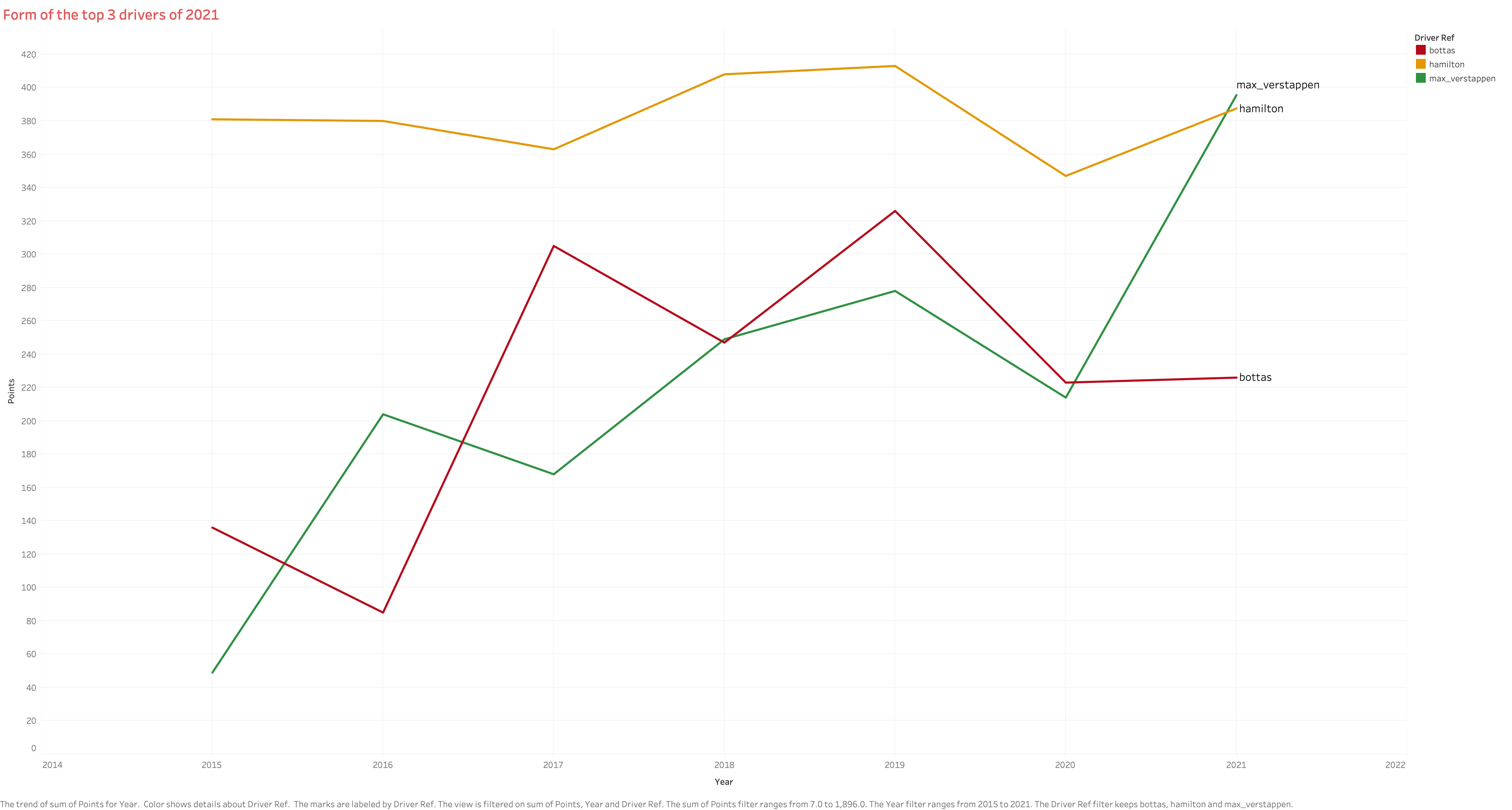
Max Verstappen is the current world f1 champion, ending the era of domination of Lewis Hamilton. Hamilton has been dominating for the past 7 years and he was the world champion in the years 2015, 2017, 2018, 2019, and 2020. He was narrowly beaten by Max Verstappen in 2021 during the last Grand Prix of the season and his former teammate Nico Rosberg by 5 points in the last Grand Prix of the season during the year 2016. Even though he is not the current world champion, he remains in excellent form and will continue to be a force to reckon with. Valtteri Bottas has been a consistent performer for Mercedes, always finishing in the top 5 of the standings.
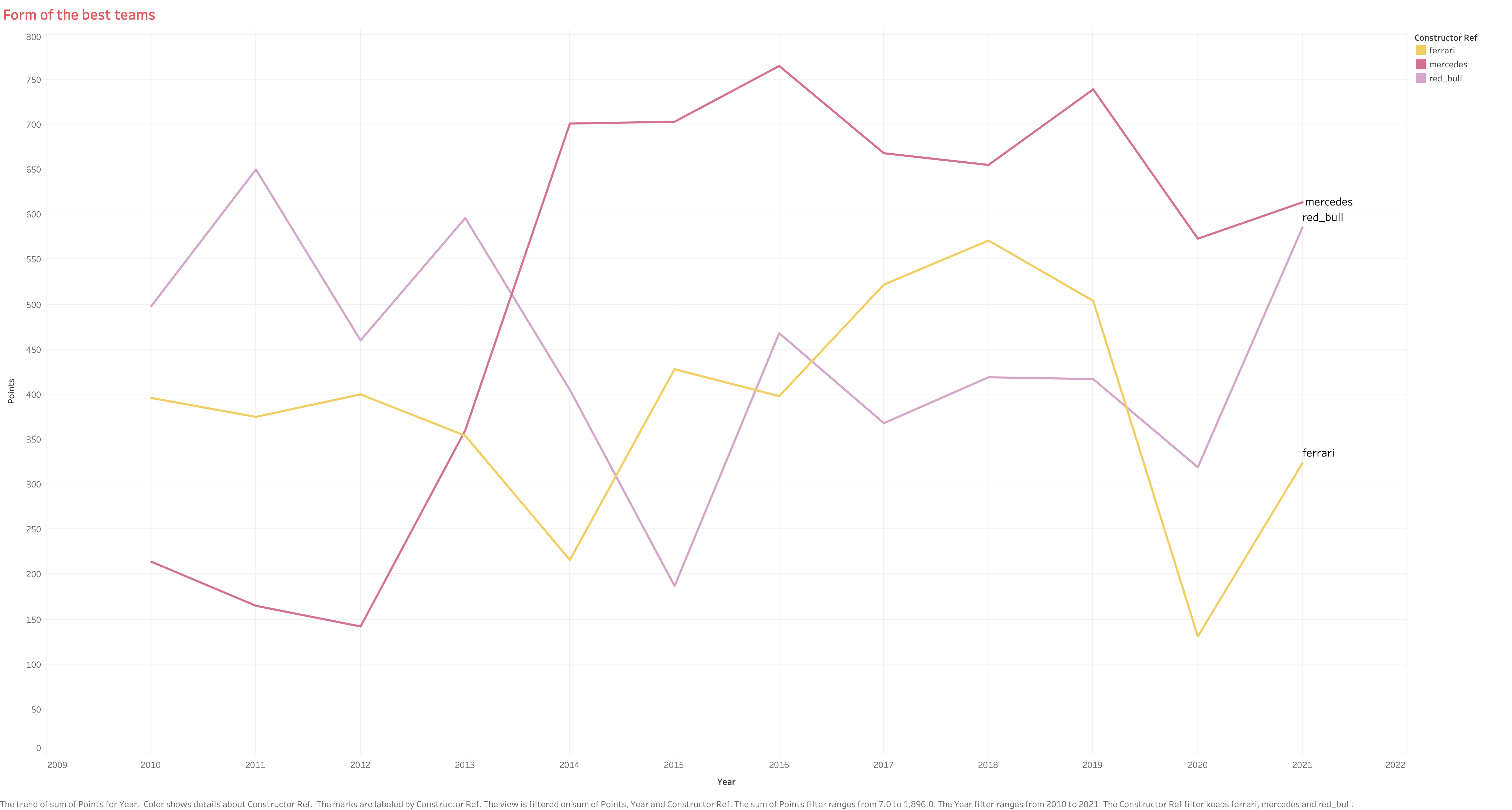
Mercedes continues to dominate f1 winning the constructors championship from 2014 to 2021. Red Bull won the constructors championship from 2010 to 2013. Red Bull’s slump began after 2014 and it has been unable to beat Mercedes for the past 7 years. Max Verstappen is probably the best bet for Red Bull to beat Mercedes in the upcoming years. Although Verstappen is the current world champion, Mercedes won this year as Valterri Bottas had a lot more points than Sergio Perez.
In the past decade, Ferrari has not been performing up to the standards of Ferrari’s golden days. Ferrari won 6 championships in a row from 1999 to 2004 when Michael Schumacher was racing. After he retired, Ferrari dropped in its performance and has not come back.
In Formula One, dominance is nothing new; the series' history is filled with it, dating all the way back to the 1950s when Juan Manuel Fangio won in a dominant Mercedes that some consider being the best racing car ever built. The vast majority of Formula One champions have triumphed in the best car available at the time. The other seven teams lack both the vehicle and the financial means to compete at the front, so they compete for fourth place, also known as the "Best of the Rest.”
To achieve anything in this game, you must be prepared to dabble in the boundary of disaster. – Stirling Moss
# Q) Which are the teams and players that face the most crashes in the past decade?
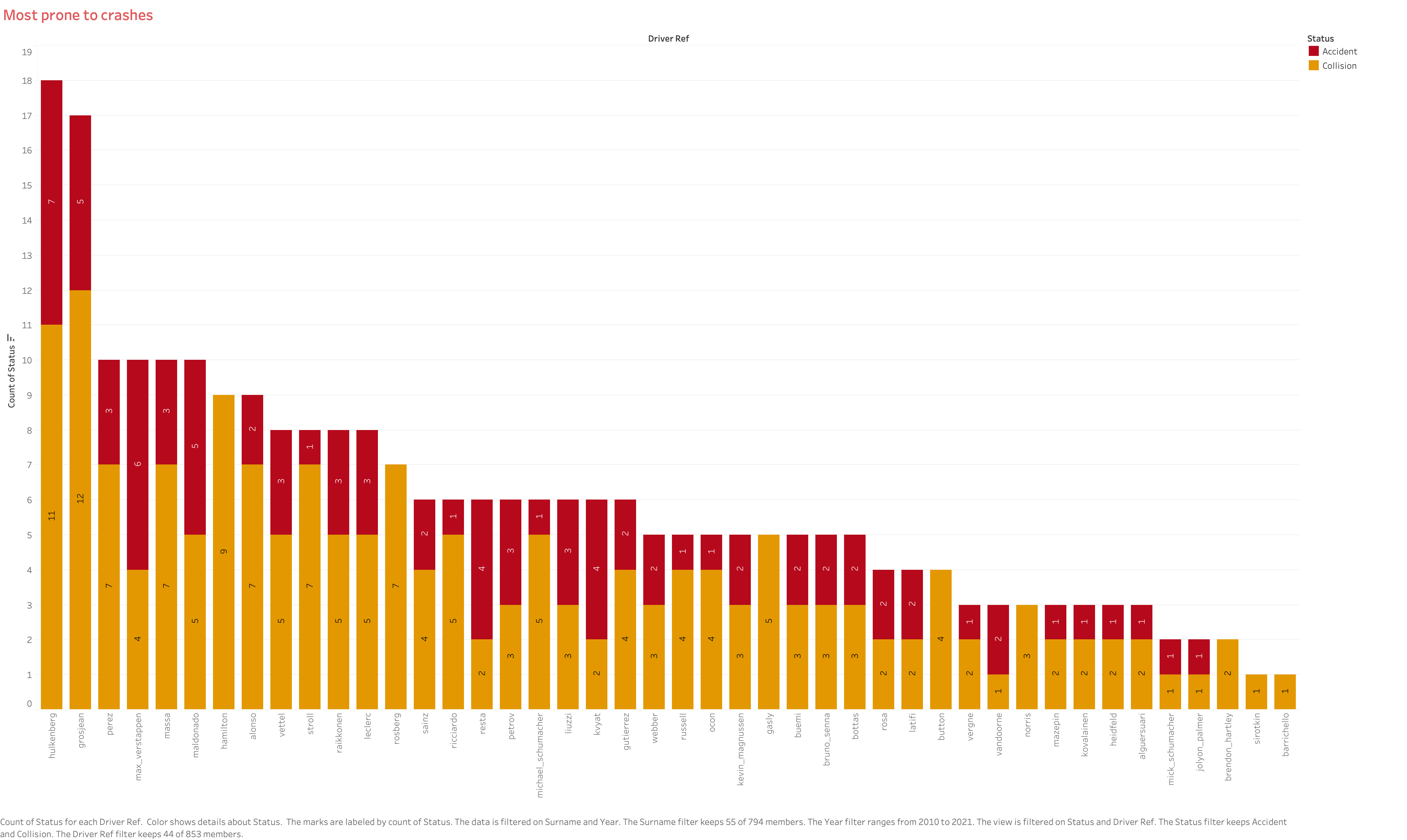
Hulkenberg faced the most crashes in the past decade(11 collisions and 7 accidents) followed by Grosjean(12 collisions and 5 accidents), Perez(7 collisions and 3 accidents), and Max Verstappen(4 collisions and 6 accidents).
F1 cars are very expensive and drivers who are more prone to crashes may not be a feasible choice for teams if their performance doesn’t match up. It is interesting to see Max Verstappen in the top 4. This might be due to his lesser experience in the beginning years of his career. Although, recently, he has been facing collisions while overtaking.
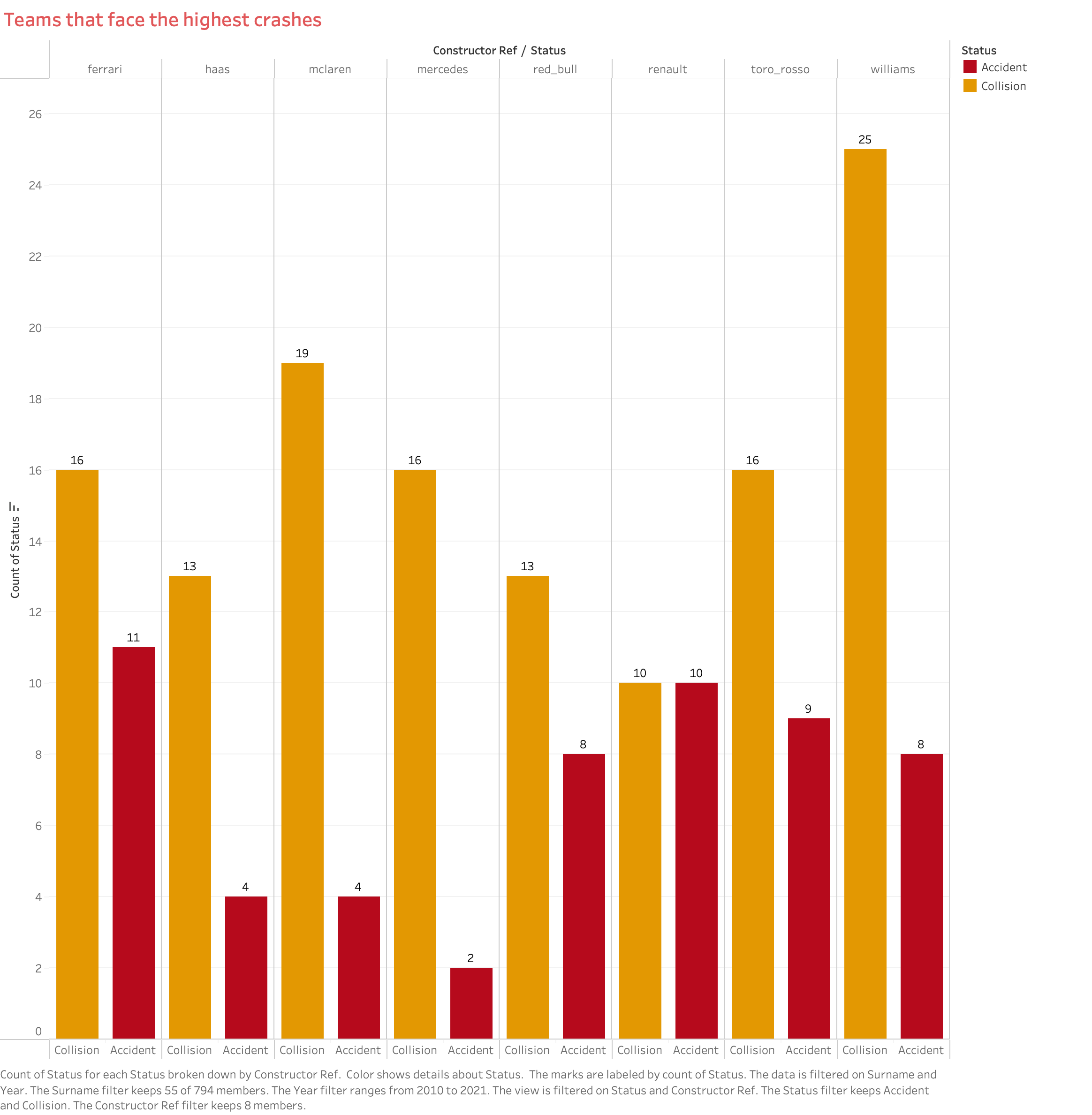
Williams has faced the most crashes as a team in F1 in the past decade(33: 25 collisions and 8 accidents) followed by Ferrari(27: 16 collisions and 11 accidents), Toro Rosso(25: 16 collisions and 9 accidents), and Mclaren(23: 19 collisions and 4 accidents).
One of the reasons why Williams is performing poorly might be because they face a lot more crashes than other teams. It is an extremely expensive ordeal for teams to fix cars. Teams like Williams have a lower overall budget than bigger teams like Ferrari and Mclaren. Therefore, it becomes a much bigger burden for small teams to face crashes.
# Inequality of Budget
2018 Budget According to RaceFans.net, in order of the 2018 championship finish
Mercedes - $400 million
Ferrari - $410 million
Red Bull - $310 million
Renault - $190 million
Haas - $130 million
McLaren - $220 million
Racing Point - $120 million
Alfa Romeo - $135 million
Toro Rosso - $150 million
Wiliams - $150 million
Bigger teams like Mercedes, Red Bull, and Ferrari have over twice the budget compared to teams like Williams and Toro Rosso. This grave inequality makes every crash and subsequent repair more cumbersome for smaller teams.
Another rule being developed for 2021 is a budget cap, which will be the first in Formula One history. The exact figure has been a matter of contention between the largest and smallest clubs, and the question of how it would be policed remains unanswered. In principle, a value of $175 million has been agreed upon, but with exclusions such as marketing costs and driver pay, the 'real' budgets of the best teams are projected to be far higher. The team's income, which is largely derived from Formula One revenues, is the other side of the budget equation.
The prize money structure in 2021 will be more meritocratic, with championship positions having a greater influence on where the money flows. Bigger teams that have bigger budgets continue to win championships and then make more money and then use the cash they receive to fuel their next race. Smaller teams are left with smaller portions of the pie and they struggle to stay afloat.
Therefore, an analysis of crashes can help constructors, especially Williams and Toro Rosso, to figure out which drivers to pick for the next Grand Prix.
# To make it fairer, shouldn’t they all drive the same car?
One idea frequently made in debates about Formula One's troubles is that, in order to discover the best driver in the world, each one should be given identical machinery to establish who is truly the best. This idea, although makes sense, is only good in theory.
Big manufacturers like Ferrari spend so much money on the sport to show how their engines are superior to the rest. Enzo Ferrari utilized Formula One to establish that his vehicles and engines were the best in the world. When the current Mercedes-Benz board of directors meets in Stuggart, they are aware that their brand is now synonymous with the quality that has catapulted its F1 team to this age of dominance. Manufacturers would have little incentive to invest millions in a single-spec series, which refers to identical machinery because the prestige of winning would be significantly lower.
The consequences are obvious: without big-name manufacturers, F1 would struggle to attract such a large demand for a spot on the race calendar, the series' standing would be lowered, and drivers would hunt for more tempting venues to race. It would just be another racing series without all of that. F1 has always been the pinnacle of motorsport in terms of both racing and technology, and the paddock is unanimous in its desire to retain it that way, albeit to differing degrees.
# Q) Who are the players that face the most engine trouble?
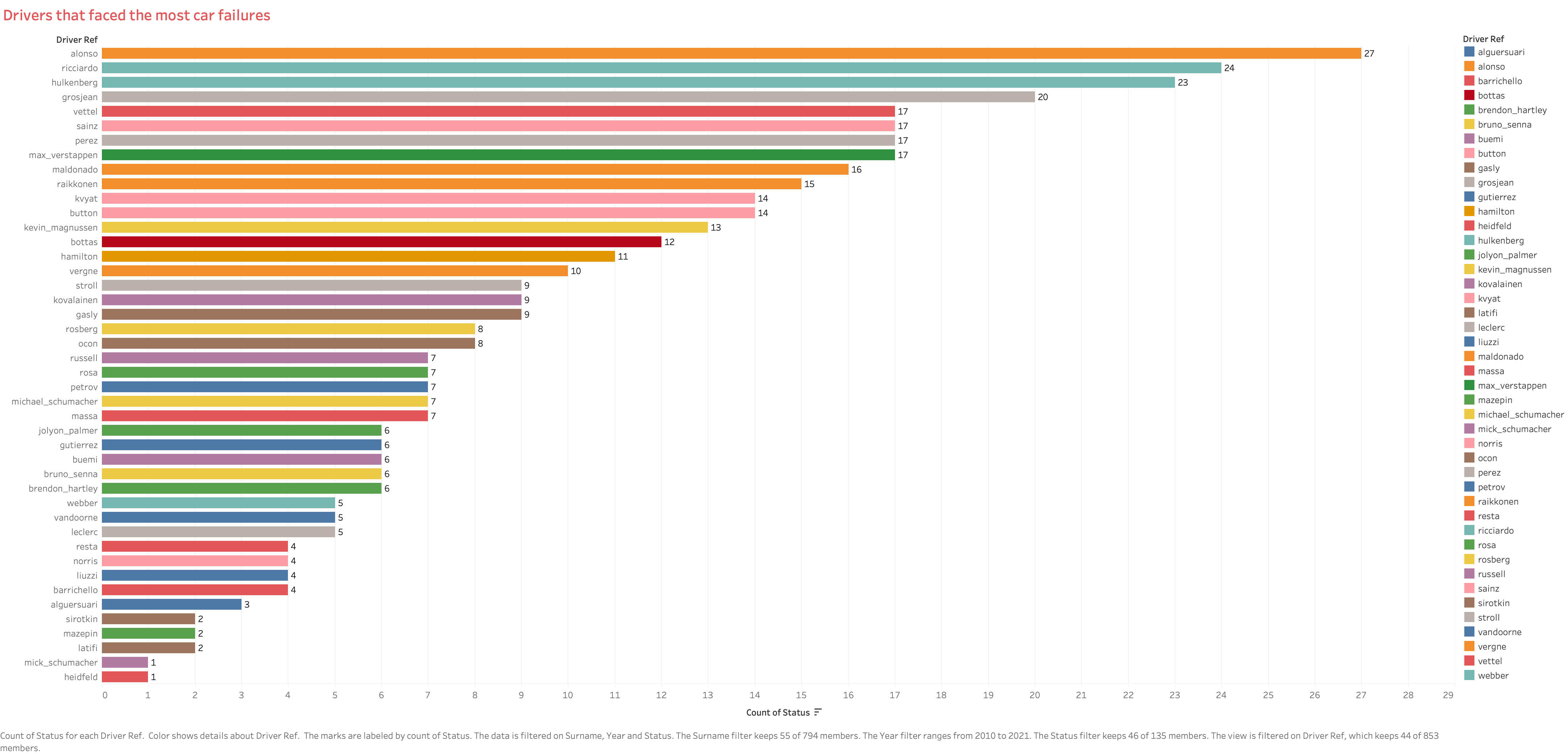
Fernando Alonso faced the highest number of car failures in the past decade(27), followed by Ricciardo(24), Hulkenberg(23), and Grosjean(20). In his tenure with Mclaren, it is a well-known fact that he was dissatisfied with the car that Mclaren makes. Despite being one of the biggest manufacturers in F1, Mclaren still faces a lot of engineering issues when it comes to F1 cars.
The reliability of the cars is questionable to the former world champion and even in the races that it is reliable, the Honda engine was underpowered and has lesser overall speed leaving him wide open to being overtaken. Fernando Alonso left Mclaren in 2019 and is making a comeback by being part of the Renault team, newly rebranded as Alpine. Engine problems are a big factor that determines the reliability of the engine. After all, you need a car to drive and it has to be fast and reliable.
Therefore, an analysis into finding which drivers face the most engine trouble can be used to determine how drivers decide which constructor to choose for the upcoming season.
If you no longer go for a gap that exists, you’re no longer a racing driver. – Ayrton Senna
# Q) Which is the most dangerous Grand Prix in the last decade?

F1 is a dangerous sport and knowing which Grand Prix has more crashes will help us determine which Grand Prix needs more safety measures and rules. Monaco Grand Prix is the most dangerous Grand Prix, having 23 crashes, followed by Singapore Grand Prix(19 crashes), British Grand Prix(17 crashes), and the Belgian Grand Prix(16 crashes).
Monaco Grand Prix is one of the most prestigious race tracks in the world. It is one of the three races, along with 24 Hours of Le Mans and the Indianapolis 500 that make up the Triple Crown of Motorsport. It has narrow circuits which makes it more dangerous and it does not adhere to the FIA’s mandated 190 miles minimum race distance for F1 races.
The history and glory of this particular circuit should not make it an exception to safety rules and regulations. Extra rules and safety measures must be implemented in these circuits to ensure the safety and welfare of drivers, and to be set as an example for other Grand Prix circuits to follow.
Races are won at the track. Championships are won at the factory. - Mercedes (2019)
# Q) Which factors should constructors focus on to make f1 cars more reliable?
No matter how fast a car can be, you can’t win with it if it isn’t reliable.
Mclaren faced the most car failures in the past decade(58), followed by Toro Rosso(57), Red Bull(46), and Williams(43).

Mclaren faces Gearbox issues the most, followed by engine and power unit failure. A big team like Mclaren should be able to produce a reliable car, otherwise, they won’t be able to retain/recruit big players that have consistent performance.

Toro Rosso faces engine problems the most, followed by Suspension and Power Unit failures. This could be the reason why Toro Rosso has had a less-than-average performance for the past decade.

Red Bull faces engine problems the most, followed by Power Unit and Electrical failures. As per the analysis, different constructors should focus on different factors to improve the reliability of the car, engine problems being the most pressing.
When I do retire, I know for a fact that I’ll never be able to replace the incredible feeling I get when I’m driving an F1 car. – Jenson Button
# Conclusion
Max Verstappen beat Lewis Hamilton this year to break his era of dominance. He is the challenger to beat with a lot of potential and he is poised to remain a good rival for years to come. Max Verstappen - Lewis Hamilton rivalry is probably going to be the best rivalry of the next decade. Mercedes continues to dominate F1 constructor championships and Red Bull is rapidly reducing the gap between the two. Could 2022 be the year Red Bull wins?
Hulkenberg faced the most crashes in the past decade as a driver and Williams faced the most crashes in the past decade as a constructor. Crashes are more cumbersome for smaller teams like Williams because they have smaller budgets. Can the new budget cap regulations really reduce the difference between bigger teams and smaller teams?
Fernando Alonso faced the highest number of car failures in the past decade. This could be one of the reasons why Mclaren couldn’t retain the former world champion. Can Alonso be a stronger competitor next year by moving to Alpine?
Monaco Grand Prix is the most dangerous circuit in F1 and safety rules and regulations need to improve in order to keep drivers safe. Will mandating new safety regulations finally happen in 2022?
Mclaren faces the most engine problems, the Gearbox being the most prominent. Will Mclaren finally fix the issues under the hood and become a competitor worthy of being backed by one of the largest manufacturers in the world?
# Future work
Weather plays an important factor in f1. It changes the entire strategy of the teams, how they use pit stops, the tires that they use, and how fast teams can go. Rainfall reduces the gap between big teams and small teams as bigger teams can’t go as fast as when it doesn’t rain. Overtakes become riskier and make drivers more prone to crashes due to hydroplaning.
The infamous crash in Nürburgring where Niki Lauda faced serious burns to his face and body might have been caused due to rain. Niki Lauda had appealed to stop the race citing concerns of rain and lack of adequate fire and safety measures but lost the appeal by one vote and was forced to race. Rainfall makes the entire Grand Prix more dangerous than it already is. Although f1 will remain a dangerous sport due to the cars being capable of going at blinding speeds, perhaps future f1 races will have more safety measures to improve, if not guarantee, the safety of drivers.
Machine learning can be used to predict who will win in future races. But since rosters of teams change like managers, engineers, drivers, etc, this has to be taken into account. Engine changes and the inclusion of new safety measures and rules should also be factored in while making predictions.